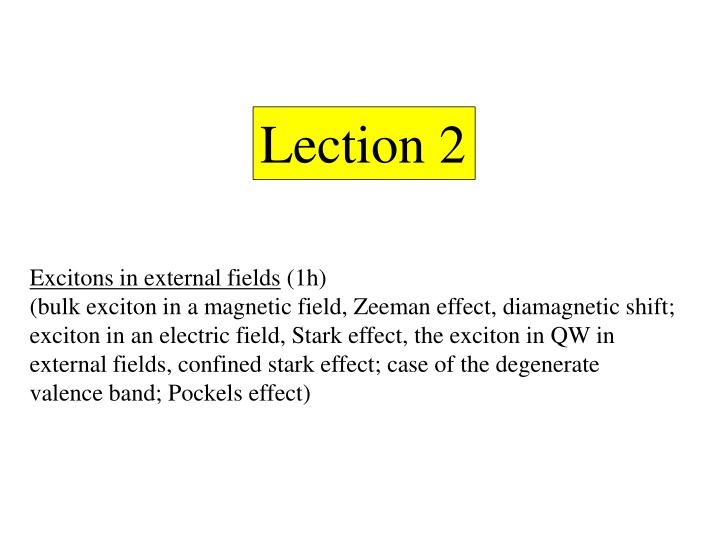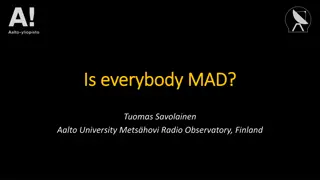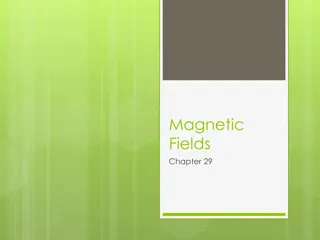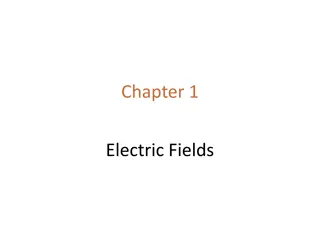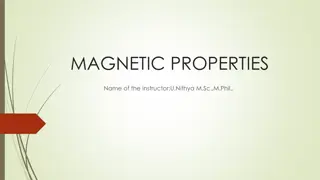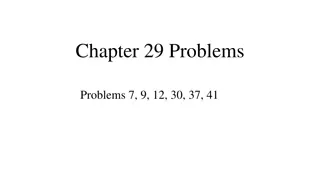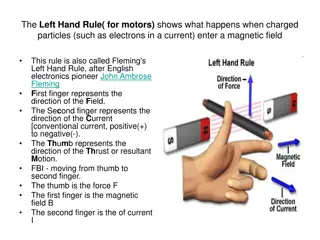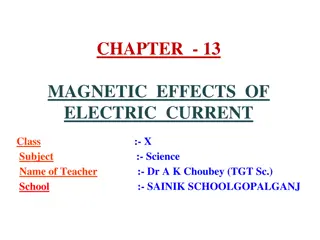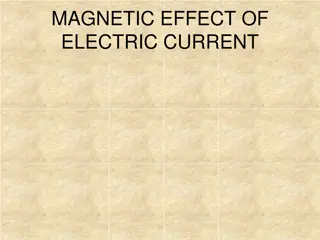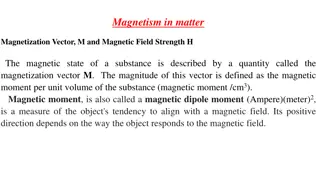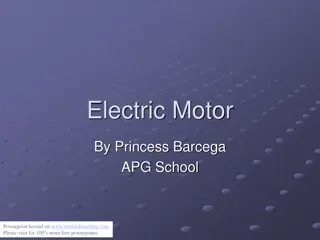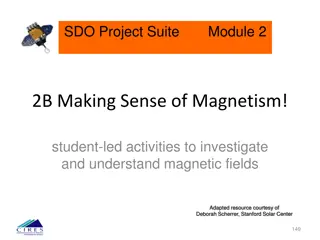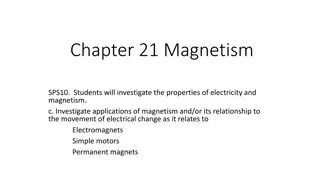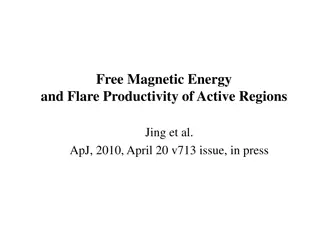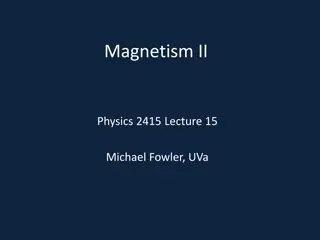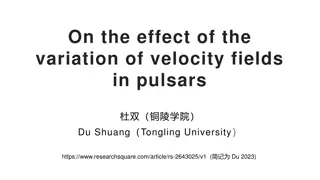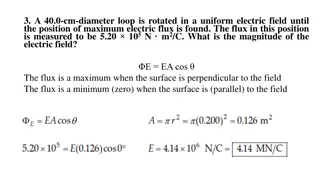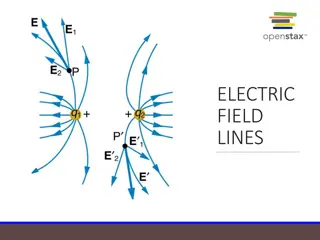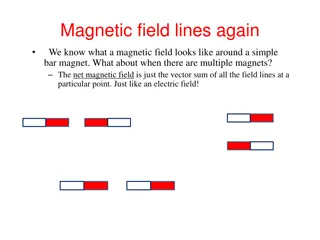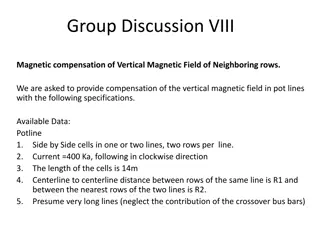Excitons in External Fields: Bulk Exciton in Magnetic & Electric Fields
Study the behavior of excitons in external fields, such as magnetic and electric fields, exploring effects like the Zeeman effect, Stark effect, confined Stark effect, and more. Dive into the intricacies of exciton dynamics in various scenarios, from simple band structures to cubic crystal environments, and analyze phenomena like the Magneto-Stark effect and Orbital Zeeman effect. Discover the complexities of exciton behavior in response to external fields.
Download Presentation

Please find below an Image/Link to download the presentation.
The content on the website is provided AS IS for your information and personal use only. It may not be sold, licensed, or shared on other websites without obtaining consent from the author.If you encounter any issues during the download, it is possible that the publisher has removed the file from their server.
You are allowed to download the files provided on this website for personal or commercial use, subject to the condition that they are used lawfully. All files are the property of their respective owners.
The content on the website is provided AS IS for your information and personal use only. It may not be sold, licensed, or shared on other websites without obtaining consent from the author.
E N D
Presentation Transcript
Lection 2 Excitons in external fields (1h) (bulk exciton in a magnetic field, Zeeman effect, diamagnetic shift; exciton in an electric field, Stark effect, the exciton in QW in external fields, confined stark effect; case of the degenerate valence band; Pockels effect)
Exciton in magnetic fields (simple band structure) e c In magnetic field we have to change obtain + p p A = 2 2 e 2 2 h 2 2 2 e ie m c ie m c e e + + + = 2 2 ( ) e A r ( ) e r ( ) h r ( , ) e r r (r ) h A A A e h h 2 2 2 2 2 2 m m r m c m c e h eh e h e h ( , ) e r r E h Relative motion and center of mass motion e c e c ( ) ( ) = + + = + + i i i A r Q i A r Q e h e ( ) ( ) ( ) = Take the trial function in the form , exp R r i Q A r R F r c ( ) F r For get equation
Relative motion Magneto stark effect Angular momentum diamagnetic 2 2 2 2 1 1 2 + e ie e e ( ) ( ) r ( ) Q F + + = 2 A r A A r ( ) * e * h 2 2 2 * e * h r c m m c m m c 2 2 Q m = E F ( ) + * e * h 2 m ( ) = A r H L 2i Angular momentum L 1 1 Orbital Zeeman effect ~ and can be small * e * h m m * h * e m m usually Contrary to spin magnetism, here we have effective mass e m = , 10 0 *~10 e m spin orbit spin mc
A Q The term Is magneto Stark effect 2 + e e Mc e c ( ) r = = A Q Q B r v B r ( ) m m c e h e c v B Is the Lorentz force E It can be compensate by an electric field because e c + E v B r The correction to energy is in the second order perturbation Corrections to effective mass and diamagnetic shift 2 2 Q B and
Magneto-Stark effect in CdS crystal in magnetic fields (Thomas Hopfield Phys. Rev. Lett. 5, 505 (1960))
In magnetic fields Additionally to spin magnetism 1). Orbital magnetism on p states 2). Diamagnetic shift 3). Magneto-Stark effect
Exciton in magnetic fields (cubic Td crystal) ( ) ( ) 0 ( ) B ( ) K ( ) = + + + K B + + ) ... + 2 2 ( H H H H H H K H B exc ex ex ex ex ex ex Here: exciton Hamiltonian in zero field and zero ( ) 0 ex H ( ) ( ) 2 ex e B B H g B = B K ( ) ( ) + + + 3 x 3 y 3 z k q B J B J B J J B x y z linear in magnetic field contribution ( ) ex x H K C K J = ( ) ( ) ( ) + + 2 y 2 z 2 z 2 x 2 x 2 y J J K J J J K J J J x y y z z linear in wave vector contribution ( ) 1 ex H K B A = ( ) ( ) x + + + 2 y 2 z BK . . c p . . c B H J J A J J p 2 x x y z bilinear in magnetic field and wavevector term ( 2 2 e m 2 2 5 2 ) ( ) 2 = + + 2 2 z 2 z 2 H K K I K I K J 1 z z m m 0 0 exciton in the absence of magnetic field
Exciton in magnetic fields (complex band structure) Exciton Hamiltonian 2 2 5 2 e = + 2 ( 2 2 e 2 h 2 K K I K / 2 [( ) ) ] H m J 1 e h 2 m r r 0 e h e c e c ( ) r ( ) r = + + = + + A Q A Q i i i i e h Because of the complex band structure we can not separate internal motion and center of mass motion in Faraday geometry we always have the term: e c e c + + + p p [( ) ( ) ]( ) A J A J Q J x x x y y y z z m 0 This term mixed 1s ground state and all p states of the internal motion and leads to two effects for moving exciton:
1) Increase exciton Zeeman splitting (2) 1( , ) S Q B = 2 z 3 z 2 (7 4 ) SB Q J J 6 z z GaAs 2 CdTe 1 / 1 ( )/ Q S r a nP S a nP 2 1 e = B B Ry 2 S 1 1/ + 2 2 m c Ry n = 2 n 0 4 A(Q) 2 ZnSe 0 0 1 2 6 cm 3 4 -1 Qz, 10
2) Decreasing of diamagnetic shift 1,8 = 2 z 2 I ( , ) B Q DQ B 1 d 1,6 2 2 1 / + S r a nP 2 3 4 1 e B y Diamagnetic shift, meV = 2 2 B D a 1 1 1/ 2 ( )/ Q m c Ry n Ry 1,4 n 0 1,2 1,0 These effects are present in narrow wells also and in QDs and in NWs 0,8 0,6 0,0 0,1 2*10 12,cm Q
In the case of degenerate valence band Due to mixing of internal and center of mass motion 1). Zeeman splitting 2). Diamagnetic shift depend on the center of mass energy
Effect of parity in the exciton spectra we have even and odd exciton quantized states Cos(3 Z/L) Sin(2 Z/L) Cos( Z/L) KNL= N
Faraday geometry d T Linear in wave vector and magnetic field contribution in bulk ( ) ( ) B K H = + 2 y 2 z . . c p H KH J J 1 ex x x D In similar 2d consider the first term 0 0 3 0 0 0 0 3 B K H 1 z z 3 0 0 0 0 3 0 0 Mixing of HH and LH excitons
1 3 d + i g = + 0 HH ( E ) x x H y d E BH i E H H HH z HH x x z z x 0 LH 0 H E E H d 1 3 y i g = 0 HH ( E ) y H x d E BH i E H H HH z HH y y z z y 0 LH 0 HH E E
Reflectivity spectrum taken from GaAs/AlGaAs QW at zero magnetic field Incident light is linearly polarized in (100), circular polarized component is analyzed 4 4000 6 8 L=300nm Intensity, a.u. 2 + 3000 H=0 2000 1,515 1,520 1,525 Energy, eV Only even states are present in this spectrum
Redistribution of exciton oscillator strength between odd and even states Incident light is linearly polarized, circular polarization is analyzed 14000 4 B=5T 12000 Intensity, a.u. 3 2 5 10 8 9 7 6 1 10000 8000 + 6000 4000 1,515 1,520 1,525 Energy, eV
Voigt geometry Cubic crystal ) ( + B HK J J HK J J 2 y z x z x y 0 3 0 0 i 3 0 0 0 i = J J y z 0 0 0 3 i 0 0 3 0 i 0 3 0 0 3 0 0 0 = J J x z 0 0 0 3 0 0 3 0
Voigt geometry Magnetic field inversion effect (a) (b) B=5T B=-5T B=10T B=-10T reflectivity, a.u. GaAs/AlGaAs L=300 nm CdTe/CdZnTe L=66 nm 1,517 1,518 1,519 1,59 1,60 1,61 photon energy, eV
Voigt geometry Wurzite crystal For the conductivity band 2 2 z 2 2 1 k k I I = + + + + + + 0 k H H k H ( , ) [ ] ( ) ( ( )) H E a b k k g H g z x y y x II z z 2 2 2 m m 7 7 II For the valence band 2 2 2 2 1 k k I I = + + 1 + 2 + 0 3 2 2 3 k H H k ( , ) [ ] ( 3 ) 3 ( ) H E a d k k k d k k k g H z 1 z x x x y y x y y II II 2 2 2 m m 9 9 II optical transitions 2 2 + D Q D Q and v y v v y v
Effect of magnetic field inversion H- H+ ( , , ) ( , , ) K H K H = ( , , ) ( , , ) K H K H Transmission spectra of CdS in magnetic field of 3.1T, H is perpendicular to C6 axis
In the structures without inversion symmetry 1). Effect of parity (due to nonreciprocal magnetic field induced birefringence) 2). Effect of inversion of magnetic field
Quantum confined Stark effect (x,y) F Lateral electric field Two effects: 1) current, 2) dissociation of the exciton E x ln B Broadening of the exciton level a e F a B B F (x,y) Transverse field No dissociation, but Stark shift 2 2 ( ) ( ) eF z E eFd E = 0.01 1 E n E = + E E E 1 1 1 exc e h 1 n 1 1 n
Stark effect in superlattice In the tight binding model we have equation + + = IC E C IC EC + 1 0 1 n n n n - Energy, - transfer integral I E = exp( ) C iK dn For the Bloch solutions: miniband: n z = + ( ) 2 cos I E K E K d 0 z z = 4I The miniband width equal 2 Effective mass = M 2 2 I d
In the presence of electric field tight binding equation ) ( + ) ( + + = 0 I C C E e Fdn C + 1 1 0 n n n E The electric field just shifts the energy 0 When the detuning becomes bigger the miniband width e Fd LOCALIZATION L Localization length e F
In superlattices Wannier-Stark localization
Quantum confined Pockels effect (Linear in electric field Birefringence) Dielectric function ( , , ) = + ( ) + ( ) + ( ) + ( ) + ( ) + k E ( ) .... i k A E B k k C E E D k E ij ij ijl l ijl l ijlm l m ijlm l m ijlm l m ij ( ) normal frequency dispersion ( ) lk natural optical activity (gyrotropy) ijl ( ) A E Pockels effect ijl l ( ) B k k spatial dispersion due to exciton motion ijlm l m ( ) C E E Kerr effect ijlm l m ( ) D k E electric field induced gyrotropy ijlm l m
1). Bulk mechanism ( ) ( ) = + ( , 0 ij , , E K K K , ) A E ij ijl l 0 0 0 0 AE z ( ) E = 0 0 AE ij z 0 Linear birefringence
2) Interface mechanism Bloch functions for the valence band are 8 1 = + ,3/ 2 ( ) X iY 8 2 1 = + ,1/ 2 2 ( ) Z X iY 8 6 1 , 1/ 2 = + 2 ( ) Z X iY 8 6 1 2 , 3/ 2 = ( ) X iY 8
Boundary conditions We can expand an arbitrary wave function in the heterostructure in the set of these functions = ( ) , F r i 8 i = 1 i In a heterostructure we need boundary conditions = F F 1). Continuity of the wavefunction A B ( ) ( ) = F F v v 2). Continuity of flax z z A B 1 H K v v - Velocity operator
Symmetry of a normal quantum well : ,2 ,2 ,2 D C S U 2 2 4 2 d d
Symmetry of a real interface In QWs based on zinc blend type semiconductors C : , , C 2 2 1 2 v
Boundary conditions taking into account low interface symmetry for valence band 8 ( ) ( ( ) F = F j j A B 2 ) ( ) = + j j F F t J J F ' j j LH x y j 3 ' jj A B m m m m 3/2 1/2 , 0 0 a a 0 0 z z hh lh Wave function for electrons = , 1/ 2 1 1/2 e (z) K 6 Hole wavefunction from the boundary conditions = , 3/ 2 1 hh (z) (z) , 1/ 2 F iG 3/2 8 8
= = + + (z) (z) cos cos sin sin F G A C k z k z B D k z k z h h Inside the well l l = ( ) ( / 2)exp ( / 2) F z F a z a h In barriers = ( ) ( / 2)exp ( / 2) G z G a z a h ( ) ( ) 1/2 1/2 / / = = 2 2 A hh A lh 2 , 2 k m k m h l here 1/2 1/2 ( ) ( ) = = 2 2 B hh B lh 2 / , 2 / m V m V h l (z) F (z) G Satisfying the boundary conditions we found and ( ) ( ) 1, 1/ 2; e 1, 3/ 2 hh + 1, 1/ 2; e + 1, 3/ 2 hh Transitions and are optically allowed
Matrix element of the transition in linear polarization 1 3 2 2 2 = = + + 2 0 2 2 2 ( ) e ( ) e cos2 M M M I I 1 2 I I 1/2,3/2 1/2, 3/2 1 3 = = (1 10)) e e 0, ( (110)), / 2, ( = = ( ) ( ) K z F z dz ( ) ( ) K z G z dz I I 1 2 Degree of linear polarization + (1 10) 2 2 I I + I I (110) = = 1 2 ( I 2 2 2 2 /3) I 3 3 (1 10) (110) 1 1
O. Krebs, W. Seidel, J. P. Andre, D. Bertho, C. Jouanin, P. Voisin: Semicond.Sci. Technol. 12, 938 (1997). InGaAs(45A)/InP(68A)
A.A. Toropov, E.L. Ivchenko, O. Krebs, S. Cortez, P. Voisin, J.L. Gentner: Phys. Rev. B 63, 35302 (2000). (1992).
Giant quantum confined Pockels effect Due to interface anisotropy
summary 1). Orbital magneton is 10 times larger the spin ones. 2). In Mixing of the center of mass motion and relative motion cal strongly modify Zeeman effect and diamagnetic shift. 3). In the structures without inversion symmetry there is effect of "parity". 4). Electric field can leads to localization. 5). Giant Pockels effect due to interfaces.
Literature Robert Knox Theory of excitons T. Godde, M. M. Glazov, I. A. Akimov, D. R. Yakovlev, H. Mariette, and M. Bayer Phys. Rev. B88, 155203 (2013) Magnetic field induced nutation of exciton polariton polarization in (Cd,Zn)Te crystals T.E.Dimock Semiconductors and Semimetals Vol. 5 K.Cho Phys. Rev. B14, 4463 (1976) Symmetry breaking effect on excitons in cubic and wuerzite structures D.G. Thomas, J.J. Hopfield Phys. Rev Lett. 5, 505 (1960)
